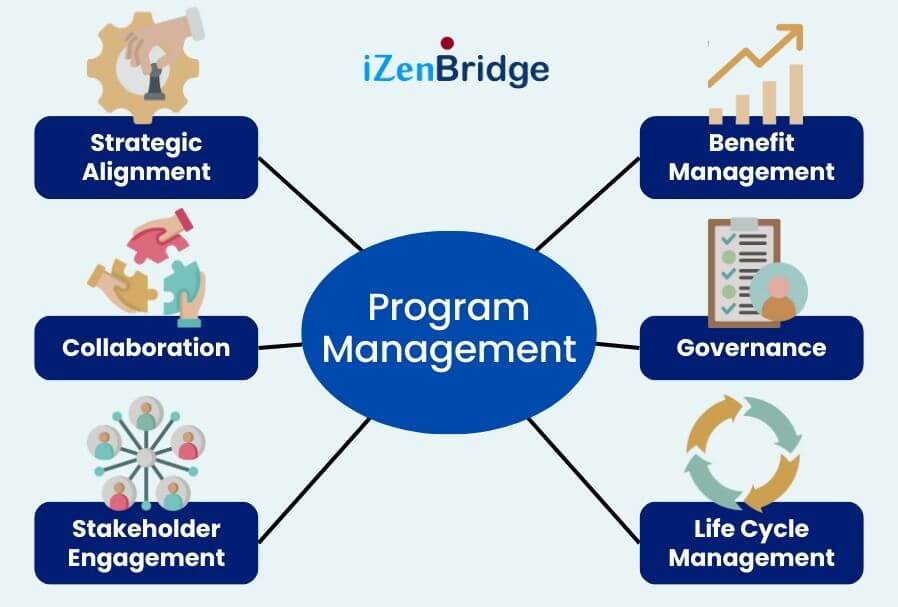

The Program Management Performance Domains are essential concepts explained in the Program Management Standard, Fifth Edition. These domains help program managers understand key aspects of program management and provide a structured approach to handling different areas. For those preparing for the PgMP (Program Management Professional) exam, mastering these performance domains is crucial, as they form the foundation of effective program management and are often tested in the exam.
Let’s explore the core performance domains and their importance in managing a successful program.
Strategic Alignment ensures that the program’s objectives are directly connected to the overall goals of the organization. For example, if an organization in the e-commerce industry aims to become a leader in its field, a program might be initiated to improve market share and operational efficiency.
In this domain, program managers focus on:
This domain also heavily influences the governance framework and benefit management processes, as both are crucial to maintaining strategic alignment. In the PgMP exam, understanding how to keep a program aligned with strategic objectives is a frequently tested topic.
The Benefit Management domain focuses on ensuring that the program delivers tangible and intangible benefits that support the organization’s goals. Benefits are what provide value to the organization, and they must be clearly identified, measured, and sustained throughout the program.
Program managers must:
For example, in an e-commerce program, reducing checkout times by 40% could be a key benefit that improves customer satisfaction and increases sales. Similarly, reducing inventory waste by 60% might boost operational efficiency. Both tangible and intangible benefits need to be measured and sustained.
Benefit Management also ties closely with Strategic Alignment, as benefits must support the overall strategic goals of the organization. The PgMP exam often tests on the identification, tracking, and realization of benefits, so it’s crucial to understand this domain in depth.
Effective Stakeholder Engagement is essential in any program. Programs involve various stakeholders, both internal (e.g., employees, leadership) and external (e.g., vendors, regulatory bodies). Stakeholders have different levels of influence and interest, and managing these relationships is a key responsibility of a program manager.
Key activities in this domain include:
Stakeholder expectations can fluctuate over time, and program managers must be adaptive, maintaining a proactive approach to managing conflicts, aligning interests, and ensuring ongoing support. Stakeholder engagement is a major area tested in the PgMP exam, focusing on relationship management and conflict resolution.
The Governance domain establishes the oversight mechanisms that guide the program toward achieving its strategic objectives. Governance ensures that decision-making, accountability, and compliance processes are in place to keep the program on track.
Program managers are responsible for:
Governance also plays a critical role in ensuring compliance with both regulatory requirements and organizational policies. A strong governance framework enables program managers to make informed decisions about continuing, modifying, or terminating program components based on performance. This is a key area in the PgMP exam, with questions focusing on setting up and managing governance structures.
Collaboration is the glue that holds a program together, ensuring that all program components (projects) and stakeholders work synergistically toward common goals. Effective collaboration leads to better communication, transparency, and alignment across the program.
In this domain, program managers focus on:
Collaboration extends beyond internal teams to include external stakeholders, such as vendors and partners. Effective collaboration reduces risks and improves overall program performance. This domain also connects with stakeholder engagement and governance. The PgMP exam often includes scenarios requiring candidates to demonstrate how they would foster collaboration in complex program environments.
The Life Cycle Management domain provides structure to the entire program, guiding it from initiation to closure. It connects all the other performance domains and helps program managers ensure a smooth flow of activities.
The program life cycle typically consists of three phases:
Life Cycle Management serves as the backbone of program management, ensuring that all performance domains are effectively integrated. Questions in the PgMP exam often test the candidate’s ability to manage programs through the entire life cycle, from initiation to closure.
Understanding and mastering the Program Management Performance Domains is essential for anyone preparing for the PgMP exam. These domains—Strategic Alignment, Benefit Management, Stakeholder Engagement, Governance, Collaboration, and Life Cycle Management—cover the core responsibilities and challenges faced by program managers in complex organizational environments.
By focusing on these areas, program managers can ensure their programs deliver value, align with strategic objectives, engage stakeholders effectively, and operate within a solid governance framework. For those aiming to pass the PgMP exam, a thorough understanding of these domains is a crucial step toward success.
Explore our PgMP exam preparation offerings to accelerate your journey toward certification and ensure your success in mastering the performance domains